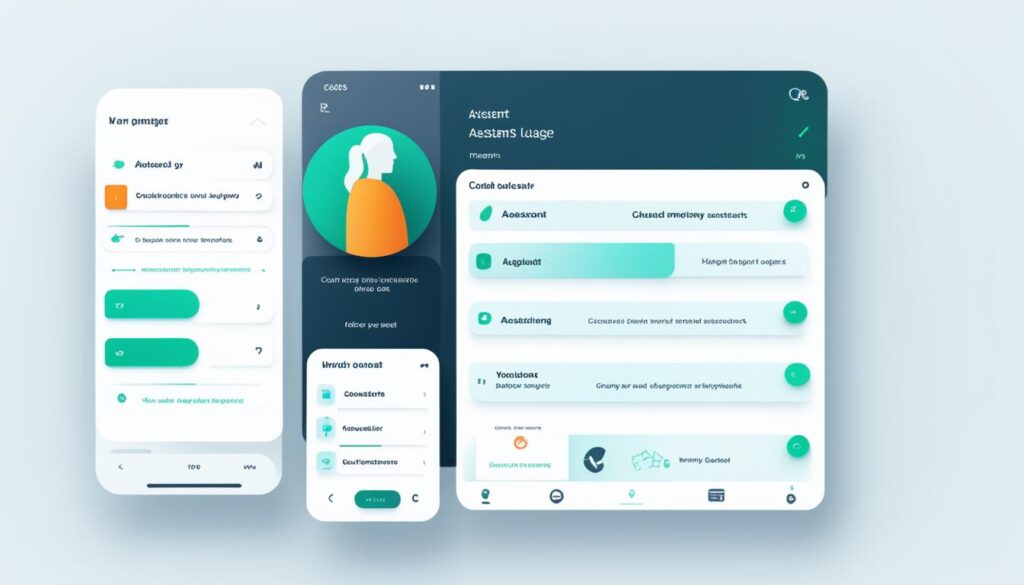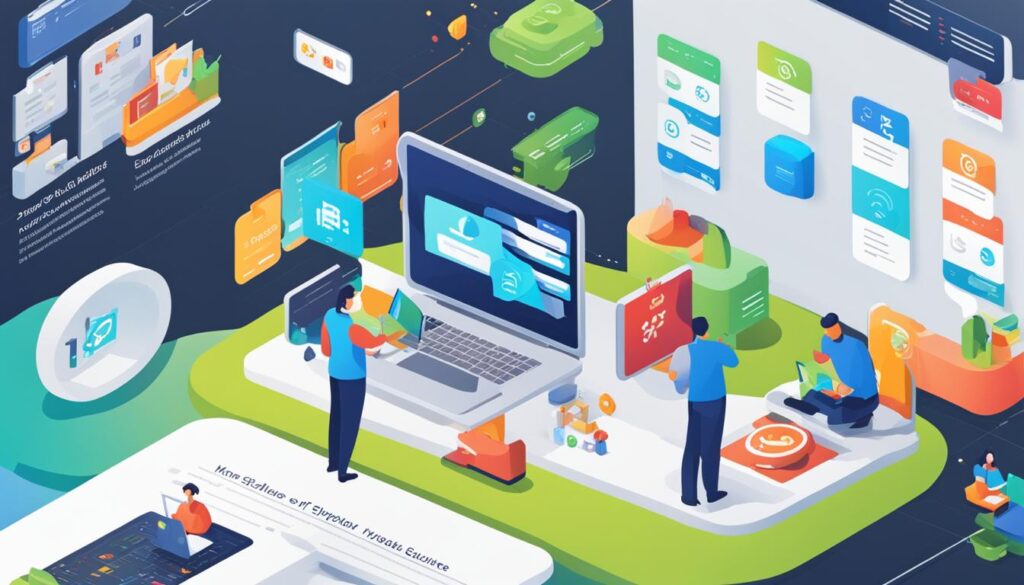Welcome to our article on web self-service solutions, where we explore the benefits and best practices of implementing this customer-centric approach. In today’s digital age, online customer support plays a crucial role in providing seamless experiences to users. By leveraging automated customer service and customer self-help tools, businesses can enhance user satisfaction, reduce support costs, and drive revenue growth.
Implementing best practices, such as an in-app resource center, in-app guidance, passive feedback widgets, AI chatbots, and building a community, can take your self-service experience to the next level. By following the footsteps of successful companies like Userpilot, Komminicate, Miro, Gleap, and Mixpanel, you can provide a user-friendly environment that empowers your customers to find answers and solutions independently.
Stay with us as we delve deeper into the world of customer self-service and discover how it can revolutionize your business. But first, let’s understand the concept of customer self-service and its significance in today’s tech-driven world.
What is Customer Self-Service?
Customer self-service is a tech-support model that empowers users to find solutions and achieve their goals within an app, without the need for human assistance. This self-service experience allows customers to access resources and tools directly, enhancing their overall satisfaction and reducing reliance on traditional support channels. By implementing self-service features such as knowledge bases, chatbots, in-app guides, FAQs, forums, and video tutorials, companies can foster a seamless and efficient user experience.
Personalized support can also be leveraged through software, enabling businesses to cater to specific user segments and provide tailored assistance. This tech-support model not only lowers online support costs but also increases operational efficiency, as customers can easily find answers to common issues on their own. By putting the power in the hands of the users, customer self-service optimizes the overall support process and ultimately boosts customer satisfaction.
Benefits of Customer Self-Service:
- Reduces online support costs
- Increases operational efficiency
- Empowers users to find answers independently
- Enhances overall customer satisfaction
- Streamlines the support process
“Customer self-service is a powerful tool that allows users to take control of their own experience, finding the answers they need quickly and easily. By investing in self-service solutions, businesses can save time, resources, and money while providing a seamless customer experience.”– Rebecca Johnson, Customer Support Specialist at SelfServe Solutions

| Features of Customer Self-Service | Benefits |
|---|---|
| Knowledge bases | Enable users to access comprehensive information and troubleshooting guides, reducing the need for manual support. |
| Chatbots | Provide instant responses to common queries, guiding users towards solutions and reducing support ticket volumes. |
| In-app guides | Orient users within the app, showcasing key features and minimizing confusion. |
| FAQs | Compile frequently asked questions in a centralized location for easy reference. |
| Forums | Create a community-driven platform for users to discuss challenges, share insights, and collaborate. |
| Video tutorials | Offer visual step-by-step guidance for complex processes, enhancing user comprehension. |
Best Practices for Implementing Self-Service Customer Experience
To create an engaging and helpful self-service customer experience, there are several best practices to consider. By implementing these strategies, you can enhance the self-service experience for your customers and streamline support processes for your business.
Building a Robust Customer Self-Service Portal
A customer self-service portal serves as a hub for customers to find solutions to their problems. It should offer a comprehensive range of resources, including:
- Knowledge base articles
- Documentation
- Video tutorials
- Support tickets
By providing multiple avenues for customers to find answers, you empower them to resolve issues on their own, reducing the need for direct support.
Interactive In-App Guidance
During the onboarding process, it’s important to provide interactive in-app guidance to help customers adopt core features quickly. This can be done through tooltips, contextual hints, and step-by-step walkthroughs. By guiding users through the application, you minimize friction and enhance their self-service experience.

Collecting Passive Feedback
To continually improve your product and customer experience, it’s essential to collect passive feedback. Implementing passive feedback tabs throughout your self-service portal allows customers to provide feedback effortlessly. This feedback can help you identify pain points, optimize processes, and enhance the overall user experience.
AI Chatbots for Instant Support
Integrating AI chatbots into your self-service portal enables customers to receive instant support, even outside of regular business hours. These chatbots can handle common inquiries, provide relevant resources, and escalate complex issues to human agents when necessary. AI chatbots improve response times, reduce support costs, and create a seamless self-service experience.
Building Community Forums
A vibrant community forum provides customers with a platform where they can connect, discuss ideas, and share knowledge. By fostering a sense of community, you empower customers to help each other, creating a self-sustaining support ecosystem. Community forums also serve as a valuable source of user-generated content that can enhance the self-service experience for all customers.
Implementing these best practices will not only enhance the self-service experience for your customers but also drive efficiency and cost savings for your business. By leveraging the power of a customer self-service portal, in-app guidance, passive feedback tabs, AI chatbots, and community forums, you can establish a seamless and effective self-service customer experience.
Types of Web Self-Service
Implementing web self-service solutions can significantly enhance customer satisfaction and reduce the workload on support teams. There are several types of web self-service that businesses can leverage to provide efficient support and empower their customers. These include:
- Knowledge Base: A comprehensive collection of articles, FAQs, and tutorials that offer self-help resources and address common customer queries. Users can access this knowledge base to find answers and troubleshoot issues independently.
- Customer Portal: A centralized platform where customers can access their accounts, manage subscriptions, track orders, and interact with support agents. It provides self-service capabilities alongside personalized assistance.
- Community Forum: An online forum where users can engage with each other, share experiences, and seek advice. Customers can participate in discussions, ask questions, and receive support from both peers and community moderators.
- AI Chatbots: Intelligent virtual assistants that use artificial intelligence to interact with customers. These chatbots can understand queries, provide instant responses, and guide users through self-service resources.
- Integrated Customer Support: Seamless integration between web self-service tools and other customer support channels like live chat, email, and phone support. This ensures a consistent and efficient support experience across different touchpoints.
Incorporating these different types of web self-service can empower customers to find solutions independently, reduce support ticket volumes, and enhance overall customer satisfaction. By aligning self-service resources with customer needs, businesses can create a superior support experience.

Real-Life Applications of Self-Service Solutions
Self-service solutions have revolutionized various industries, providing efficient and convenient experiences for customers while streamlining operations for businesses across retail, banking, and healthcare sectors. Let’s explore how self-service solutions have transformed these industries.
Retail Industry
In the retail industry, self-service solutions such as kiosks and self-checkout systems have gained immense popularity. These solutions enable customers to complete transactions, access product information, and check prices without the need for human assistance. Self-service kiosks have become a common sight in grocery stores, convenience stores, and even fast-food chains, offering a seamless and efficient shopping experience. Customers can easily locate products, compare prices, and make purchases at their own pace.
Banking Sector
The banking industry has embraced self-service solutions, transforming the way customers manage their finances and seek support. Online banking platforms have become the norm, enabling customers to perform various transactions such as checking balances, transferring funds, and paying bills from the comfort of their homes or on the go through mobile apps. Additionally, chatbots and virtual assistants have been implemented to provide instant support and answer customer queries, ensuring round-the-clock assistance.
Healthcare Field
In healthcare, self-service solutions have revolutionized patient experiences. Patient portals have allowed individuals to access their medical records, schedule appointments, and communicate securely with healthcare providers. Telemedicine has also gained traction, enabling patients to consult with doctors remotely, reducing the need for in-person visits for non-emergency cases. These self-service solutions have not only enhanced convenience for patients but also improved efficiency and reduced administrative burdens for healthcare facilities.
These real-life applications of self-service solutions in retail, banking, and healthcare illustrate the versatility and efficiency they bring to industries. By empowering customers to complete tasks independently and access information at their convenience, these solutions enhance overall customer satisfaction and streamline business operations.
| Industry | Self-Service Solutions |
|---|---|
| Retail | Self-service kiosks, self-checkout systems |
| Banking | Online banking platforms, chatbots, virtual assistants |
| Healthcare | Patient portals, telemedicine |
Benefits of Self-Service Solutions and How to Create a Successful Self-Service Solution
Self-service solutions offer numerous benefits for businesses and customers alike. By implementing a self-service system, companies can significantly reduce costs, eliminating the need for extensive customer service teams. This cost reduction is achieved by empowering customers to find solutions on their own, reducing the volume of support inquiries and the need for dedicated agents.
In addition to cost savings, self-service solutions also lead to improved customer satisfaction. By providing convenient and efficient support options, businesses can exceed customer expectations and deliver a seamless user experience. Customers appreciate the ability to access resources at any time, without having to wait for a support agent. This self-service approach allows customers to resolve issues quickly, increasing overall satisfaction.
Furthermore, self-service solutions increase operational efficiency by streamlining the customer service process. With a self-service portal or knowledge base in place, customers can find answers to common questions independently, freeing up support agents to focus on more complex inquiries. This efficiency boost leads to faster response times and increased productivity within the customer service department.
To create a successful self-service solution, businesses should start by understanding their customers’ needs. Conducting user research and collecting feedback can help identify the most pressing pain points and create targeted resources. Additionally, it is crucial to make the self-service solution easy to use and navigate. Clear menu structures, search functionality, and well-organized content contribute to a positive user experience.
Keeping the self-service content up-to-date is essential, as outdated or incorrect information can lead to frustration and erode customer trust. Regularly reviewing and updating the knowledge base, FAQs, and other resources ensures accuracy and relevancy. Lastly, promoting the self-service solution effectively is crucial for its success. Businesses should actively communicate and educate customers about the availability and benefits of the self-service option.
In summary, implementing a self-service solution provides significant benefits, including reduced costs, improved customer satisfaction, and increased operational efficiency. By understanding customer needs, creating user-friendly interfaces, maintaining up-to-date content, and promoting the solution effectively, businesses can create a successful self-service experience that enhances the customer journey and supports their overall business goals.
FAQ
What are the benefits of implementing web self-service solutions?
Implementing web self-service solutions provides a seamless experience for customers to use a product without friction, while helping businesses reduce support costs, improve customer loyalty, boost product adoption, and drive revenue growth.
What is customer self-service?
Customer self-service is a tech-support model where companies provide customers with the resources to find answers to problems and achieve their goals inside the app, without relying on human assistance.
What are the best practices for implementing a self-service customer experience?
Best practices for implementing a self-service customer experience include building a customer self-service portal with a variety of resources, providing interactive in-app guidance, collecting passive feedback, implementing AI chatbots, and building community forums.
What are the different types of web self-service?
The different types of web self-service include knowledge bases, customer portals, community forums, AI chatbots, and integrated customer support.
How are self-service solutions applied in real-life industries?
In real-life, self-service solutions are applied in various industries such as retail (self-checkout systems), banking (online banking platforms, chatbots), and healthcare (patient portals, telemedicine).
What are the benefits of self-service solutions and how can I create a successful self-service solution?
Self-service solutions offer benefits such as reduced costs, improved customer satisfaction, and increased efficiency. To create a successful self-service solution, businesses should understand customer needs, make the solution easy to use, keep content up-to-date, and promote the solution effectively.
